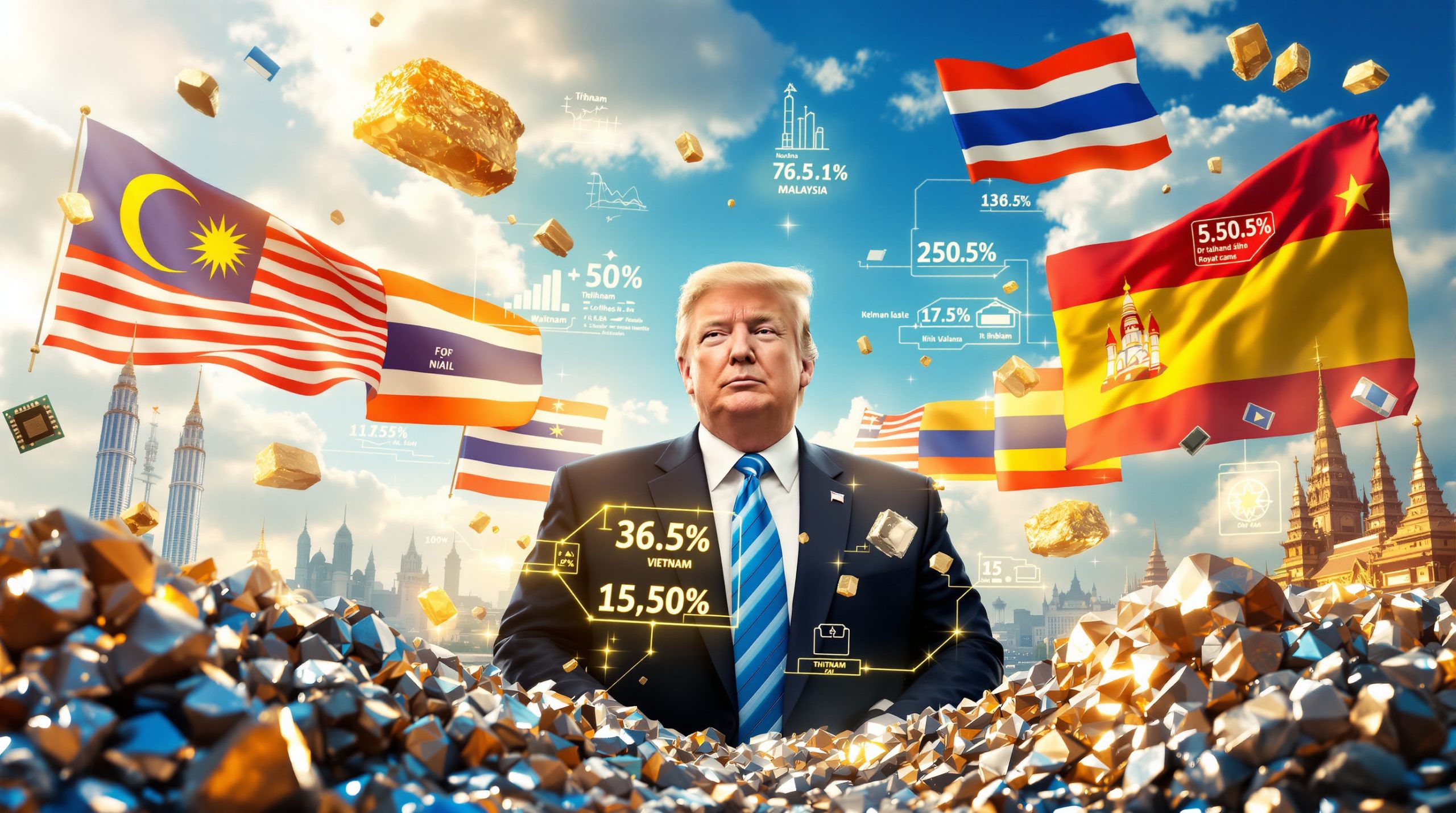The Safe-Haven Connection: Why Gold Rises During Global Uncertainty
Gold has historically served as a financial refuge during times of geopolitical instability. This relationship stems from gold's intrinsic characteristics as a tangible asset with inherent value, independent of government control. When international tensions escalate, investors typically shift capital toward gold safe-haven insights, driving prices upward through increased demand.
Recent price movements illustrate this pattern clearly. Gold reached unprecedented heights in 2024, with prices surpassing $3,600 per ounce, representing a substantial year-over-year increase that has dramatically outperformed many other asset classes. This remarkable appreciation reflects heightened global tensions across multiple regions and growing concerns about financial system stability.
Key Factors Behind Gold's Geopolitical Price Sensitivity
- Preservation of wealth during currency devaluation – Gold maintains purchasing power when fiat currencies lose value during political crises
- Portfolio diversification away from risk assets – Investors reduce exposure to markets directly affected by geopolitical events
- Limited correlation with traditional financial markets – Gold often moves independently from stocks and bonds during turmoil
- Physical possession outside the banking system – Provides security when financial institutions face uncertainty
- Historical precedent as monetary standard – Deep cultural and institutional memory of gold as ultimate money
Gold's performance during periods of uncertainty isn't merely psychological—it's rooted in fundamental economic principles. When governments face instability, their currencies typically weaken, while gold, being nobody's liability, remains resistant to political manipulation. This explains why gold investment amid uncertainty consistently outperforms during periods of geopolitical tension.
How Regional Conflicts Drive Gold Price Movements
Middle Eastern Tensions and Energy Market Disruption
Regional conflicts in the Middle East create a dual impact on gold prices. First, they trigger direct safe-haven buying as investors seek protection from uncertainty. Second, these conflicts often threaten energy supply chains, potentially leading to oil price spikes that generate inflationary pressures—further enhancing gold's appeal as an inflation hedge.
The interconnection between energy markets and gold prices creates a feedback loop: disruptions to oil shipping routes or production facilities immediately impact energy costs, which then filter through economies as inflation, reinforcing gold's attractiveness. This relationship helps explain why gold often responds dramatically to developments in oil-producing regions.
When energy prices rise due to geopolitical impact on gold prices, central banks often face the difficult choice between fighting inflation (raising rates) or supporting economic growth (maintaining lower rates). This policy dilemma typically benefits gold, as either outcome—persistent inflation or economic stimulus—creates favorable conditions for precious metals.
European Political Instability
Political fragmentation across Europe has emerged as a significant driver of gold demand. France's recent governmental challenges exemplify the political volatility affecting major economies. With potential power shifts toward populist movements, investors increasingly question the stability of European institutions and the euro currency.
This uncertainty manifests in gold markets through:
- Increased physical gold purchases by European investors seeking protection from political instability
- Growing allocations to gold-backed ETFs as institutional hedges against currency volatility
- Central bank gold acquisitions among smaller European nations concerned about regional stability
- Wealth preservation strategies among high-net-worth individuals anticipating potential currency devaluation
European debt concerns further amplify these effects, with many nations carrying debt-to-GDP ratios exceeding 100%. This fiscal reality constrains policy options during crises, creating additional uncertainty that drives investors toward strategic gold investment.
Central Bank Gold Accumulation: The Geopolitical Dimension
Strategic Diversification Away from Dollar Reserves
Central banks worldwide have dramatically accelerated gold purchases, adding substantial tonnage annually to official reserves. This trend reflects strategic moves to reduce dependency on the US dollar amid growing geopolitical tensions and sanctions regimes.
The scale of this official sector buying represents a fundamental shift in global reserve management, providing substantial support for gold prices. Notable accumulation has occurred among:
- BRICS nations (Brazil, Russia, India, China, South Africa)
- Middle Eastern oil exporters seeking to diversify sovereign wealth
- Southeast Asian emerging economies building financial resilience
- Eastern European countries hedging against regional instability
This reserve diversification doesn't merely reflect portfolio management—it signals a strategic repositioning within the international monetary system. By increasing gold holdings, central banks create more policy flexibility and reduce vulnerability to foreign financial pressures.
Gold as a Sanctions-Resistant Asset
Gold's unique status as a non-sovereign asset makes it particularly valuable during periods of international sanctions. Unlike digital currency reserves that can be frozen or blocked through the global banking system, physical gold holdings remain accessible regardless of diplomatic tensions.
This sanctions-resistance quality has driven countries facing geopolitical isolation to substantially increase their gold reserves. Russia's dramatic shift from dollar assets to gold following 2014 sanctions exemplifies this strategy, with its central bank more than doubling gold reserves in subsequent years.
Physical gold offers several key advantages in sanctions-constrained environments:
- Cannot be frozen or seized through digital financial networks
- Enables bilateral trade settlement outside SWIFT or traditional banking
- Provides monetary backing that isn't subject to foreign veto
- Creates credibility for alternative payment mechanisms
As sanctions increasingly become tools of first resort in international disputes, gold's role as a sanctions-resistant reserve asset continues to strengthen, creating structural support for prices independent of traditional investment demand.
The BRICS Factor: How Alternative Economic Alliances Impact Gold
Resource Control and Market Influence
The expanding BRICS alliance now encompasses nations controlling a significant portion of global oil production and representing billions of people worldwide. This concentration of resource wealth creates significant leverage in international markets and directly influences commodity pricing, including precious metals.
The alliance's growing economic coordination poses challenges to Western-dominated financial systems, potentially accelerating shifts toward alternative settlement mechanisms that favor gold. Their collective influence extends beyond member states through:
- Strategic partnerships with resource-rich developing nations
- Control of critical shipping routes and port infrastructure
- Dominance in key commodity markets beyond energy
- Growing influence in international financial institutions
The BRICS nations' combined resources create formidable economic weight. Beyond oil, member states control substantial portions of global production in strategic metals, including platinum group metals critical for industrial applications. South Africa and Russia together account for approximately 80% of global platinum production—a metal essential for catalytic converters, electronics, and military applications.
Development of Gold-Backed Alternative Currencies
BRICS nations have actively pursued the development of gold-backed currency alternatives to challenge dollar hegemony. These initiatives aim to create settlement mechanisms that reduce vulnerability to Western financial sanctions while providing more stable monetary foundations.
While still evolving, these currency projects could fundamentally alter gold's role in the international monetary system. The potential introduction of a BRICS gold-backed currency represents a significant development that could structurally increase gold demand regardless of short-term price movements.
Such a currency would:
- Create direct physical gold demand for reserves backing the system
- Establish a formal role for gold in international settlements
- Provide an alternative to dollar-based trade for participating countries
- Set precedent for further gold-backed financial instruments
The potential success of these initiatives remains uncertain, but even partial implementation would significantly impact gold's monetary role and market dynamics.
How Does Dedollarization Affect Gold Prices?
The Shift Away from USD Reserves
Dedollarization—the systematic reduction of dollar dependence in international trade and reserves—has accelerated amid growing geopolitical divisions. This process directly benefits gold through:
- Diversification of national reserves away from dollars toward gold
- Development of alternative payment systems that incorporate gold
- Bilateral trade agreements specifying settlement in gold or gold-backed currencies
- Repatriation of gold reserves previously held in Western financial centers
The pace of dedollarization has intensified as sanctions have increasingly been deployed as geopolitical tools, creating strong incentives for affected nations to develop dollar alternatives. Gold serves as a natural bridge asset during this transition.
This shift isn't limited to sanctioned nations. Many countries, including traditional U.S. allies, have begun gradually reducing dollar exposure to mitigate concentration risk. These incremental moves, while less dramatic than headline-grabbing sanctions evasion, cumulatively create significant structural support for gold demand.
Parallel Markets and "Dark Fleet" Phenomena
Geopolitical tensions have spawned parallel market systems that circumvent traditional Western-controlled channels. The emergence of "dark fleets"—hundreds of tankers with obscured ownership transporting sanctioned oil—illustrates how alternative trading mechanisms develop in response to geopolitical restrictions.
These parallel systems increasingly incorporate gold as a settlement medium, creating additional demand sources outside conventional markets. The scale of these operations has expanded significantly, with estimates suggesting hundreds of vessels now operate in these shadow fleets, moving millions of barrels daily.
These alternative trading systems demonstrate how sanctions regimes can inadvertently accelerate the development of parallel economic structures that often rely on gold as a trusted settlement medium. Rather than isolating targeted economies, restrictions may be accelerating the development of alternative financial architectures that fundamentally alter gold's role in international commerce.
Investment Implications: Portfolio Positioning During Geopolitical Uncertainty
Gold Allocation Strategies
Effective portfolio protection during geopolitical instability requires strategic gold allocation. Investment approaches vary based on risk tolerance and objectives:
| Allocation Strategy | Typical Percentage | Primary Objective | Implementation Method |
|---|---|---|---|
| Core Protection | 5-10% | Long-term wealth preservation | Physical bullion, allocated storage |
| Tactical Positioning | 10-20% | Active response to escalating tensions | ETFs, mining equities |
| Maximum Security | 20-30%+ | Preparation for severe system disruption | Combination of physical and paper gold |
These allocations should be calibrated based on individual circumstances, investment horizons, and risk tolerance. Investors with significant exposure to assets directly affected by geopolitical events (emerging market securities, multinational corporations, or energy-intensive businesses) may benefit from higher allocations as specific hedges against those exposures.
Physical vs. Paper Gold Considerations
The form of gold exposure becomes increasingly important during acute geopolitical crises. Physical vs paper gold offers maximum security against systemic financial risks but presents storage and liquidity challenges. Paper gold (ETFs, futures) provides convenience but introduces counterparty risk—precisely what investors seek to avoid during severe geopolitical disruptions.
A balanced approach might include:
- Core physical holdings in secure, accessible storage
- ETF positions for tactical adjustments and liquidity
- Mining equities for operational leverage during price increases
- Precious metals funds for professional management
Each vehicle offers distinct advantages and disadvantages. Physical gold eliminates counterparty risk but requires secure storage solutions. ETFs provide convenient exposure but depend on functioning financial markets. Mining stocks offer potential amplified returns but introduce operational and company-specific risks beyond geopolitical factors.
For investors primarily concerned with wealth preservation during severe disruptions, allocated physical gold stored in secure, jurisdictionally diversified vaults offers maximum protection. Some mutual funds specialise in this approach, providing 100% backing with physical metals stored in LBMA-approved facilities, combining security with relative convenience.
Historical Precedents: Gold Performance During Past Geopolitical Crises
Comparative Crisis Analysis
Examining gold's performance during previous geopolitical flashpoints provides valuable context for current market dynamics:
| Historical Event | Gold Price Movement | Duration of Impact | Contributing Factors |
|---|---|---|---|
| 1979 Iran Hostage Crisis | +214% | 14 months | Oil supply disruption, inflation spike |
| 1990 Gulf War | +15% | 7 months | Middle East instability, oil price volatility |
| 2001 September 11 Attacks | +5% immediate, +18% within year | 12+ months | Safe-haven demand, monetary easing |
| 2008 Russia-Georgia War | +4% immediate | 2 weeks | Limited regional impact |
| 2014 Crimea Annexation | +14% | 6 months | Western sanctions, Russian gold buying |
| 2022 Russia-Ukraine War | +12% immediate, +22% within year | Ongoing | Commodity disruption, sanctions regime |
This historical analysis reveals that gold's response varies significantly based on the crisis scope, energy market impacts, and monetary policy reactions. The most substantial price movements typically occur when geopolitical events coincide with inflationary pressures and monetary accommodation.
The duration of price impacts depends on several factors. Short-term price spikes often occur immediately following crisis events, while sustained price appreciation typically depends on:
- Whether the crisis triggers lasting changes to monetary policy
- The impact on energy and commodity markets
- Central bank responses in affected regions
- Structural changes to international financial relationships
These historical patterns suggest that initial price responses often underestimate the full impact of major geopolitical shifts, especially when they trigger fundamental reconsiderations of reserve currencies or international payment systems.
Gold vs. Other Safe-Haven Assets During Geopolitical Turmoil
Comparative Performance Analysis
While gold remains the traditional geopolitical safe haven, other assets compete for this role. Understanding their relative performance helps investors optimize protective positioning:
| Asset | Advantages During Geopolitical Crises | Limitations | Recent Performance (2023-2024) |
|---|---|---|---|
| Gold | Physical ownership, no counterparty risk, universal acceptance | Storage costs, no yield | +62.9% |
| US Treasury Bonds | High liquidity, dollar-denominated | Vulnerable to inflation, tied to US policy | -4.2% (price return) |
| Swiss Franc | Monetary discipline, political neutrality | Central bank intervention, negative rates | +5.3% vs USD |
| Bitcoin | Censorship resistance, limited supply | Volatility, regulatory uncertainty, energy dependence | +6.6% |
| Defense Sector Equities | Direct beneficiary of conflict | Ethical concerns, budget dependency | +28.4% |
Gold's substantial outperformance against other traditional safe havens during recent geopolitical tensions underscores its enduring role during international crises. Even digital alternatives like Bitcoin have significantly underperformed physical gold during this period of heightened uncertainty.
This performance divergence highlights the different risk factors affecting each safe-haven asset. While Bitcoin offers theoretical censorship resistance, its dependence on functioning digital infrastructure and exchanges limits its practical utility during severe crises. Similarly, sovereign bonds provide liquidity but remain vulnerable to the very governmental instabilities that investors seek protection from during geopolitical turmoil.
Future Outlook: Geopolitical Trends and Gold Price Projections
Structural Factors Supporting Higher Gold Prices
Multiple structural factors suggest continued upward pressure on gold prices independent of short-term market fluctuations:
- Accelerating central bank purchases as reserve diversification continues
- Expanding BRICS membership and resource control
- Development of alternative financial architectures incorporating gold
- Growing sovereign debt concerns across developed economies
- Persistent inflation risks from deglobalization and supply chain restructuring
These factors create a supportive environment for gold regardless of specific geopolitical flashpoints, potentially establishing a new price floor substantially above historical averages.
The structural nature of these changes distinguishes the current gold market from historical periods of price appreciation. Rather than responding to isolated crises, today's gold market reflects fundamental reconsideration of international monetary relationships and reserve asset preferences that could sustain higher prices regardless of short-term headline developments.
Technical Price Projections and Analyst Forecasts
Technical analysis suggests significant upside potential for gold, with multiple forecasts projecting prices reaching $4,000-$8,000 by 2029. These projections typically incorporate:
- Long-term trend analysis showing sustained momentum
- Supply-demand fundamentals including mine production constraints
- Monetary policy expectations amid high sovereign debt levels
- Geopolitical risk premiums based on multiplying flashpoints
While such forecasts necessarily involve uncertainty, the convergence of technical projections with fundamental geopolitical drivers provides strong support for a continued structural bull market in gold.
These projections should be considered within the context of broader economic scenarios. In optimistic cases where geopolitical tensions ease and monetary systems stabilize, gold may experience more modest appreciation. However, continued or escalating tensions, combined with monetary challenges, could drive prices toward the higher end of forecast ranges.
Disclaimer: All price projections involve significant uncertainty and should not be the sole basis for investment decisions. Past performance does not guarantee future results, and geopolitical situations can change rapidly, affecting asset prices unpredictably.
FAQ: Common Questions About Gold and Geopolitics
How quickly does gold typically respond to geopolitical events?
Gold markets generally react immediately to significant geopolitical developments, often within hours of major announcements or incidents. The magnitude and sustainability of price movements depend on several factors:
- The severity and potential duration of the conflict
- Direct impacts on energy or commodity markets
- Monetary policy responses from major central banks
- Pre-existing market positioning and sentiment
Initial price spikes may partially retrace if tensions de-escalate quickly, but sustained conflicts typically produce extended price support.
The most immediate reactions typically occur in futures markets, with physical gold markets sometimes experiencing delayed responses due to logistics and premium adjustments. This can create temporary disconnects between paper and physical gold prices during acute crises, with physical premiums often expanding significantly.
Does gold perform better during regional or global conflicts?
Global conflicts or those involving major powers typically generate stronger and more sustained gold price increases than localised regional tensions. This differential response occurs because:
- Global conflicts threaten international trade and financial systems
- Major power involvement raises stakes and uncertainty
- Worldwide investor participation amplifies safe-haven flows
- Monetary policy responses tend to be more significant
However, regional conflicts affecting energy production or critical shipping routes can have disproportionate impacts regardless of geographic scope.
The distinction between regional and global conflicts has blurred in today's interconnected world. Regional tensions that might previously have remained contained now frequently trigger broader responses through alliance structures, economic sanctions, or commodity market disruptions that amplify their impact on gold.
How do interest rates affect gold's response to geopolitical events?
Interest rate environments significantly influence gold's response to geopolitical developments. During low or negative real interest rate periods, gold typically demonstrates stronger upward momentum during crises because:
- The opportunity cost of holding non-yielding gold is reduced
- Monetary policy often becomes more accommodative during crises
- Inflation concerns heighten when rates cannot rise substantially
- Currency debasement fears increase during accommodative policy periods
Conversely, high real interest rate environments may dampen gold's crisis response as yield-bearing alternatives remain attractive despite uncertainty.
This relationship explains why gold's response to geopolitical events can vary significantly depending on the prevailing monetary policy backdrop. The same crisis might trigger dramatically different gold price responses depending on whether central banks have room to tighten policy or feel compelled to ease further.
What role does platinum play in geopolitical investment strategies?
Platinum offers a complementary precious metal exposure with distinct geopolitical sensitivities. As an industrial metal with critical applications in automotive, chemical, and defense industries, platinum responds to both safe-haven demand and supply disruption concerns.
The metal's concentrated production—with South Africa and Russia controlling approximately 80% of global output—creates significant geopolitical leverage and supply vulnerability. Historical price relationships suggest platinum could potentially outperform gold during certain geopolitical scenarios, particularly those affecting major platinum-producing regions.
Platinum's industrial applications in defense technology, aerospace, and critical infrastructure further enhance its strategic importance during geopolitical tensions. Countries seeking to secure supply chains for these applications may increase strategic stockpiles, creating additional demand beyond investment flows.
Further Exploration:
Readers interested in learning more about the relationship between geopolitics and precious metals can explore related educational content from financial education organizations, investment research firms, and record gold highs analysis that analyze reserve asset trends and international monetary developments.
For investors considering implementing precious metals strategies, consulting with qualified financial professionals who specialise in hard assets and geopolitical risk management can provide personalised guidance appropriate to individual circumstances and risk tolerances.
Investment Disclaimer: Precious metals investments involve risks including price volatility, storage considerations, and potential liquidity constraints. Past performance does not guarantee future results. This information is educational in nature and not intended as investment advice. Consult qualified financial professionals before making investment decisions.
Looking for an Edge in ASX Mineral Discoveries?
Discovery Alert provides instant notifications on significant ASX mineral discoveries through its proprietary Discovery IQ model, helping investors identify actionable opportunities before the broader market. Discover why historic mineral finds can generate substantial returns by exploring the dedicated discoveries page and begin your 30-day free trial today.




